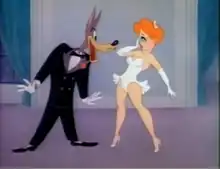Red (animated character)
Red, also known as Miss Vavoom in the 1990s, is an American animated character, created by Tex Avery, who appears in several MGM short films and Tom and Jerry films. She is a fictional nightclub singer and dancer who is usually making all men in the room crazy, especially a Wolf character who — in vain — tries to seduce and chase her. Red debuted in MGM's Red Hot Riding Hood (May 8, 1943), a modern-day variant of the fairy tale "Little Red Riding Hood".[1]
| Red | |
|---|---|
 "Wolfie" and Red in the 1945 animated short Swing Shift Cinderella. | |
| First appearance |
|
| Created by | Tex Avery |
| Designed by | Claude Smith |
| Voiced by | Sara Berner (1943–1945) Connie Russell (1943; singing) Imogene Lynn (1945–1947; singing) Ann Pickard (1945; singing) Teresa Ganzel (1990–1993) Grey Griffin (1996, 2010–2013) |
| In-universe information | |
| Species | Human |
| Gender | Female |
She appeared in seven animated shorts in the Golden age of American animation, and was revived to appear in many Hanna-Barbera TV cartoon series from the 1990s until 2013 due to later changing sensibilities.
History
According to Avery, the character originated at the army, where he helped the sergeant plan training films for the animators at MGM. When the film was finished, Avery got down to the projection room, where he always "ran the picture for the producer and the whole group". When the sergeant spotted the picture, much like the wolf, he roared. Word soon spread about the picture among the army. The version he showed was the uncensored version, which had a scene that the grandma marries the wolf and has children with him, and the Hays Office found that the scene strongly suggested bestiality. The scene was ultimately cut for the theatrical release.[2][3]
The character was designed by Claude Smith and animated by Preston Blair, who said that the picture originally was just planned around the wolf and the grandmother (which her design was inspired by the caricatures of Peter Arno), but they soon focused mainly on Red. In fact, the character was not rotoscoped, but in fact was drawn from his own imagination.[4][5] The first cartoon, garnering 15,000 bookings, was so successful that it garnered various sequels, the first being The Shooting of Dan McGoo.[6]
Appearances
Shorts
| # | Title | Release Date | Notes |
|---|---|---|---|
| 1 | Red Hot Riding Hood | May 8, 1943 | Red's debut. |
| 2 | Who Killed Who? | June 19, 1943 | Cameo, seen on the picture. |
| 3 | Big Heel-Watha | October 21, 1944 | In a Screwy Squirrel cartoon; as Minnie Hot-Cha in unmasked native american indian form. |
| 4 | The Shooting of Dan McGoo | March 3, 1945 | In a Droopy cartoon |
| 5 | Swing Shift Cinderella | August 25, 1945 | As Cinderella |
| 6 | Wild and Woolfy | November 3, 1945 | In a Droopy cartoon |
| 7 | The Hick Chick | June 15, 1946 | Cameo, as a nurse in hen form. |
| 8 | Uncle Tom's Cabaña | July 19, 1947 | As Little Eva |
| 9 | Little Rural Riding Hood | September 17, 1949 | The final Red's Theatrical cartoon, Reused footage from Swing Shift Cinderella |
| 10 | Thanks a Latte | 1999 | Cameo, In production with Cartoon Network |
Television
- Tom & Jerry Kids (1990–1993) as Miss Vavoom
- Droopy, Master Detective (1993) as Miss Vavoom[7]
Films
- Quest for Camelot (1998) (Cameo)
- Tom and Jerry Meet Sherlock Holmes (2010)
- Tom and Jerry: Robin Hood and His Merry Mouse (2012) as Maid Marian
- Tom and Jerry's Giant Adventure (2013)
Video games
- Droopy's Tennis Open (2002) as Bubbles Vavoom
Comics
- Wolf & Red (1995) (Dark Horse Comics)
- Droopy (1995) (Dark Horse Comics)
- Comics and Stories (1996) (Dark Horse Comics)
Known voices
Red is voiced by the following characters
- Sara Berner (Debut, 1943–1945) Speaking Voice
- Connie Russell (Debut, 1943) Singing Voice
- Colleen Collins (1945) Speaking Voice
- Imogene Lynn (1945) Singing Voice
- Ann Pickard (1945) Singing Voice
- Teresa Ganzel (1990–1993) as Miss Vavoom
- Grey DeLisle (1996, 2010–2013)
Censorship and later retirement
Before 1983, all shorts containing Red were banned from television due to restrictions of the Seal of Good Practices, which explains the character would not appear in The Tom and Jerry Comedy Show in 1980 regarding her sexual nature. The character revived in 1990, 7 years after the suspension of the Television Code. Red would continue to appear in the cartoons until Tom and Jerry's Giant Adventure in 2013, which marks her final appearance due to changing sensibilities for children’s programmings.[8]
References
- Red at Don Markstein's Toonopedia. Archived from the original on December 21, 2016.
- Floraine, Place-Verghnes (2006). "4: Facing Contemporary Politics". Tex Avery : a unique legacy, 1942-1955. John Libbey Publishing. p. 61.
- Barrier, Michael (2009-03-03). "COMMENTARY : Tex Messaging". Retrieved 2022-06-30.
- Red Hot Riding Hood Concept Drawings by Preston Blair Group of 4 (MGM, 1943).... (Total: 4 Original Art)
- Maltin, Leonard (1980). Of Mice and Magic: A History of American Animated Cartoons. McGraw-Hill. pp. 287–289. ISBN 0-07-039835-6.
- Animation Anecdotes #361
- Erickson, Hal (2005). Television cartoon shows: an illustrated encyclopedia, 1949 through 2003. McFarland & Co. p. 289. ISBN 9780786422555.
- Several of the earlier medias, like Animaniacs and The Powerpuff Girls from example, have featured voluptuous and scantily clad female leads in the past. Parents became more concern about the sexualization in children’s programs as these female types are later dropped out of the picture.